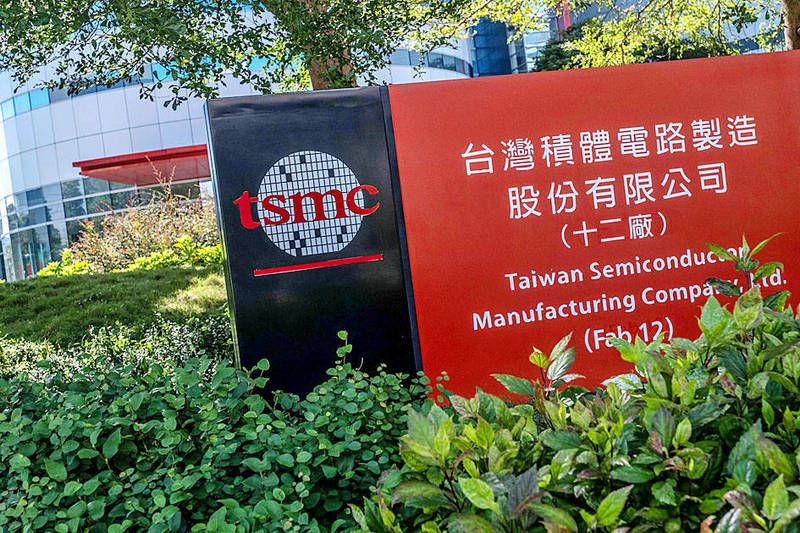《TAIPEI TIMES》TSMC cuts capital spending 18 percent

The Taiwan Semiconductor Manufacturing Co headquarters in Hsinchu is pictured on Wednesday. Photo: Lam Yik Fei, Bloomberg
By Lisa Wang / Staff Reporter
Taiwan Semiconductor Manufacturing Co (TSMC, 台積電) yesterday slashed its capital spending by up to 18 percent for this year to US$36 billion, as sluggish demand for smartphones and PC’s curtailed demand for its 7-nanometer chips and lowered capacity utilization.
Demand for its chips also dwindled as customers continued digesting excessive inventory, the world’s largest contract chipmaker told a virtual investor conference. The inventory correction is expected to carry through the first half of next year, leading to a reduction in TSMC’s factory utilization during the period, the company said.
In response to softness in medium-term demand outlook, TSMC is tightening capital spending budget for this year, it said.
TSMC in July was set to spend between US$40 billion and US$44 billion on new facilities and equipment, but a bulk of this year’s capital expenditures are to focus on advanced technologies expansion, it said.
In its efforts to optimize capacity, the chipmaker said it also adjusted its 7-nanometer chip capacity expansion at its Kaohsiung facilities, but it would continue bundling new 28-nanometer chip capacity at the site as scheduled.
“Starting the fourth quarter this year, our 7-nanometer and 6-nanometer capacity utilization will not be as high as it has been in the past three years. We expect this to persist for a few quarters through the first half of 2023,” TSMC CEO C.C. Wei (魏哲家) said.
Most of TSMC’s 7-nanometer and 6-nanometer chips are used in smartphones and computers, Wei said, adding that customers are pushing back new product schedules, causing a slide in demand.
“Probably in 2023, the semiconductor industry will likely decline, but TSMC also is not immune,” Wei said. “Our business will be more resilient than the overall semi industry.”
Next year is expected to be a growth year for TSMC next year, following a 35 percent year-on-year growth in revenue this year, he said.
Manufacturing tool delivery challenges are also a major factor behind TSMC’s cuts to capital spending this year, particularly with photolithography tools, Wei said.
TSMC is to be “more conservative” about new capacity planning next year, as market demand has become so weak that there is a likelihood that a further business correction could take place next quarter, Wei said, adding that data center and automotive-related applications remain steady.
TSMC yesterday maintained an unchanged revenue growth target of an annual compound growth rate of between 15 percent and 20 percent over the next few years.
In response to investors’ concerns regarding the US’ latest semiconductor export restrictions to China, Wei said “the new regulation sets the control threshold at a very high-end specification, which is primarily used for artificial intelligence, or supercomputing applications. Therefore, our initial assessment of the impact on TSMC is limited and manageable.”
TSMC said it has been granted a one-year license to expand 28-nanometer and 16-nanometer chips at its China fab in Nanjing. China accounted for 8 percent of TSMC’s revenue last quarter, down from 13 percent in the previous quarter.
TSMC yesterday posted a record-high quarterly net profit of NT$280.87 billion (US$8.81 billion), up 18.5 percent quarter-on-quarter, or annual growth of 79.7 percent.
Gross margin surged to 60.4 percent last quarter from 59.1 percent in the second quarter, and 51.3 percent in the third quarter last year.
Looking forward, revenue this quarter is expected to be little changed, at a range from US$19.9 billion to US$20.7 billion, compared with US$20.23 billion last quarter, it said, adding that demand for 5-nanometer and 28-nanometer chips are robust.
Gross margin is to be between 59.5 percent and 61.5 percent, TSMC said.
When asked whether TSMC would accelerate capacity expansion overseas to cope with rising geopolitical tensions, Wei said the company would increase “overseas portions of manufacturing based on customers’ needs, business opportunity, operation efficiency and cost economics.”
The company is evaluating whether to build a new fab in Europe, Wei said.
新聞來源:TAIPEI TIMES













